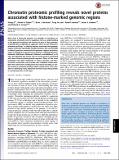Chromatin proteomic profiling reveals novel proteins associated with histone-marked genomic regions
Author(s)
Ji, Xiong; Abraham, Brian J.; Lee, Tong Ihn; Jaenisch, Rudolf; Bradner, James E.; Young, Richard A.; Dadon, Daniel Benjamin; ... Show more Show less
DownloadJi-2015-Chromatin proteomic.pdf (1.895Mb)
PUBLISHER_POLICY
Publisher Policy
Article is made available in accordance with the publisher's policy and may be subject to US copyright law. Please refer to the publisher's site for terms of use.
Terms of use
Metadata
Show full item recordAbstract
More than a thousand proteins are thought to contribute to mammalian chromatin and its regulation, but our understanding of the genomic occupancy and function of most of these proteins is limited. Here we describe an approach, which we call “chromatin proteomic profiling,” to identify proteins associated with genomic regions marked by specifically modified histones. We used ChIP-MS to identify proteins associated with genomic regions marked by histones modified at specific lysine residues, including H3K27ac, H3K4me3, H3K79me2, H3K36me3, H3K9me3, and H4K20me3, in ES cells. We identified 332 known and 114 novel proteins associated with these histone-marked genomic segments. Many of the novel candidates have been implicated in various diseases, and their chromatin association may provide clues to disease mechanisms. More than 100 histone modifications have been described, so similar chromatin proteomic profiling studies should prove to be valuable for identifying many additional chromatin-associated proteins in a broad spectrum of cell types.
Date issued
2015-03Department
Massachusetts Institute of Technology. Department of Biology; Whitehead Institute for Biomedical ResearchJournal
Proceedings of the National Academy of Sciences
Publisher
National Academy of Sciences (U.S.)
Citation
Ji, Xiong, Daniel B. Dadon, Brian J. Abraham, Tong Ihn Lee, Rudolf Jaenisch, James E. Bradner, and Richard A. Young. “Chromatin Proteomic Profiling Reveals Novel Proteins Associated with Histone-Marked Genomic Regions.” Proceedings of the National Academy of Sciences, March 9, 2015, 201502971.
Version: Final published version
ISSN
0027-8424
1091-6490